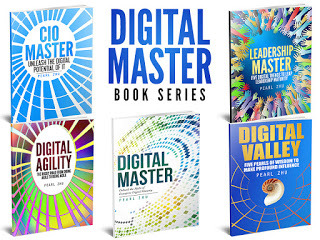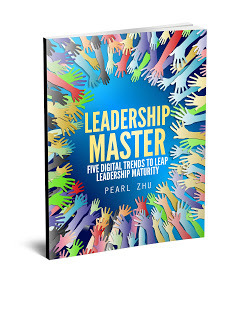Pearl Zhu's Blog, page 1315
July 22, 2016
Three-Step to Climb the Pyramid of Leadership Profundity
 At the siloed industrial era, leadership efficiency is often dependent on the hierarchical level of authority and brute force style of command and control, it’s often about how loud you can speak or how hard you can push. However, digital means information flow, people centricity, innovation and transparency. Hence, digital leadership must go deeper, to climb the pyramid of leadership profundity and practice the power of pull, and lead more effortlessly.
At the siloed industrial era, leadership efficiency is often dependent on the hierarchical level of authority and brute force style of command and control, it’s often about how loud you can speak or how hard you can push. However, digital means information flow, people centricity, innovation and transparency. Hence, digital leadership must go deeper, to climb the pyramid of leadership profundity and practice the power of pull, and lead more effortlessly.
In-depth knowledge: Knowledge is power! Knowledge is information in use; and it’s information that supports the decision-making process. Knowledge is an expression of understanding relating information and experience accumulated over time, about known facts and past events. The knowledge life cycle is significantly shortened at the digital era, and lots of commodity knowledge are just clicks away, and therefore, knowledge is also the capacity for learning, reasoning, understanding, and similar forms of mental activity; aptitude in grasping truths, relationships, facts, meanings, etc. It means knowledge has to be updated periodically due to the increasing speed of change and digital hyperconnected digital new normal. Learning knowledge is just the first step, at up level, one should connect dots between transdisciplinary disciplinaries and co-create new knowledge. A knowledgeable leader or professional shouldn’t have a “graduated attitude,” to stop learning, or only be interested in providing answers to fulfill egos, in fact, they should learn how to ask open questions and gain collective wisdom. Seeing the big picture into which the knowledge fits.
Cognitive understanding: Knowledge by itself is nothing if you do not understand how to apply it and make it useful. Cognitive understanding means people acquire knowledge through thinking and sensing. When we explore the mental process of acquiring new knowledge through thought, experience, and senses, the cognition involves exploring varieties of meanings/thoughts and abandoning old and establishing new relations. Too often people take the easy path, think and work at a superficial level rather than spend the time to understand what is going on underneath. Insight is an understanding of cause and effect based on identification of relationships and behaviors within a model, context, or scenario. Cognition is a perception, sensation, and insight. And insight is the understanding of a specific cause and effect in a specific context. It enable you to identify the root cause of a problem or the core issues of a situation which leads to cognitive understanding and resolution.
 Multidimensional thinking: The difference between knowledge and wisdom is thinking, and especially lateral, nonlinear or multi-dimensional thinking, a holistic view. Our minds are conditioned based on our own belief systems, education and past happenings. We act based on these unconscious thoughts. Choosing thoughts consciously would be arduous. But it’s the very thoughts decide who you are, the quality of your thinking decides your professionalism and leadership profundity. For example, Critical Thinking is important on how you process information, which is a complex mental activity that encompasses all aspects of one's cognitive styles, and the skills associated with critical thinking include exploring a problem from multiple perspectives, at the deeper level, it has creativity embedded in it. Analyzing the possibilities and projected outcomes provides an opportunity to apply Critical Thinking to the situation, Multidimensional Thinking is a skill that has to be developed through a process, and continuous practices.
Multidimensional thinking: The difference between knowledge and wisdom is thinking, and especially lateral, nonlinear or multi-dimensional thinking, a holistic view. Our minds are conditioned based on our own belief systems, education and past happenings. We act based on these unconscious thoughts. Choosing thoughts consciously would be arduous. But it’s the very thoughts decide who you are, the quality of your thinking decides your professionalism and leadership profundity. For example, Critical Thinking is important on how you process information, which is a complex mental activity that encompasses all aspects of one's cognitive styles, and the skills associated with critical thinking include exploring a problem from multiple perspectives, at the deeper level, it has creativity embedded in it. Analyzing the possibilities and projected outcomes provides an opportunity to apply Critical Thinking to the situation, Multidimensional Thinking is a skill that has to be developed through a process, and continuous practices.
Knowledge is power. Digital leaders and professionals can practice expert power based on their in-depth knowledge, cognitive understanding, and multidimensional thinking skills to enforce the power, and amplify their leadership influence via profundity
Follow us at: @Pearl_Zhu
Published on July 22, 2016 23:46
"CIO Master" Book Tuning XXXXXXXII: From “IT vs Business” to “IT as Business”
The shift from "IT vs. Business" to "IT as Business," is not only possible, but the ‘must have’ prerequisite in building a true digital organization.
 Digital means hyperconnectivity and interdependence. However, in most organizations today, the gap between business and IT still exists, and many think it is even enlarged due to the different parts of the company involve changes with different speed. The chasms between business and IT are caused by silo mentality or isolated process, ‘the ownership vs. stewardship’ political dispute or ‘he said, she said’ miscommunication. So in order to run a holistic digital organization, how can businesses close the gap and improve the organizational maturity from “IT vs. Business” to IT as a business?
Digital means hyperconnectivity and interdependence. However, in most organizations today, the gap between business and IT still exists, and many think it is even enlarged due to the different parts of the company involve changes with different speed. The chasms between business and IT are caused by silo mentality or isolated process, ‘the ownership vs. stewardship’ political dispute or ‘he said, she said’ miscommunication. So in order to run a holistic digital organization, how can businesses close the gap and improve the organizational maturity from “IT vs. Business” to IT as a business?
The trust relationship between business and IT is a two-way street: The cause of most of the conflict is a lack of trust, in both directions. Trust is earned by business and IT working as a whole, head to head and hand in hand. Why isn't there trust? There’re a lot of reasons technically, economically, politically and cognitively. Businesses need to really gain an in-depth understanding of IT, just like IT has to know the business through. However, most of the business stakeholders are tempted to rely much on an estimation matrix than on IT side practice. Sometimes, the business just underestimates the complexity of technology and information management. For examples, problems arise when expertise boundaries are crossed, either way, a business user thinks he/she knows more technically than the IT specialist and imposes his/her "way" on the project and it could be very counter-productive and it can work the other way around. And dig deeper through the symptom described above, the silo mindset is the root cause which causes the problems as following: IT and business do not share the common understanding of the problem, and such misunderstanding leads to ineffective decisions, and consequently, things get so bad, the project fails, and it’s lose-lose situation for both parties, and the company as a whole suffers.The trust also means IT and business work closely to deliver the business solution with optimal speed. The business needs to understand the change and complexity nature of IT, while IT can lead the charge in improving business-IT relations by simply not taking their customer for granted and focusing on customers as if they were in a competitive market.
First seeking to understand then be understood”: Typically, one starts with communication and a process that allows people to discover that both sides of the business want to achieve the best results, but they see the outcome as something different and expect to achieve it differently. For example, there's a natural friction between the company executives’ business goals and IT leader’s risk management goals, whereas the other CXO roles tend to be driven by growing the business. But at the end of the day, all CXO roles have their crosses to bear, and most CIOs have the depth of knowledge to understand the nature of the role when they accept it. Top executives also need to have the breadth of business acumen to understand the business as a whole and the digital ecosystem, as nowadays, the territories between functions, companies, and industries are blurring, or often converged. Thus, interdisciplinary knowledge and even transdisciplinary insight would help business leaders to both gain insight and work hard at investing in a positive relationship with their executive peers by first 'seeking to understand then be understood.'
 The specialized generalists who understand both IT and business are in strong demand: IT and business must rely on each other's strengths and use each other in the most relevant capacity. The cross-functional teams are given the opportunity to work together, not only learning from each other and tackling the issues together, but striving for the same business goal and achieve high expectation. It should start at the strategic level, IT, marketing, finance, HR., etc all have its own subsection of the overall business strategy, and their own capacity to implement the strategy. What is needed are lots more impartial and independent hybrids who can help businesses define a robust and rigorous set of needs, work with IT to deliver the solution and with both parties to ensure the desired outcome happens. Rather than continuing with the "point the finger" culture, intelligent companies should put the capabilities of both IT and Business personnel to work on building integrated business capabilities and achieve strategic goals seamlessly. It is invaluable for both IT and business to know what's going in each other's space and why. IT and business must rely on each other's strengths and use each other in the most relevant capacity, both parties have to understand exactly how each one operates.
The specialized generalists who understand both IT and business are in strong demand: IT and business must rely on each other's strengths and use each other in the most relevant capacity. The cross-functional teams are given the opportunity to work together, not only learning from each other and tackling the issues together, but striving for the same business goal and achieve high expectation. It should start at the strategic level, IT, marketing, finance, HR., etc all have its own subsection of the overall business strategy, and their own capacity to implement the strategy. What is needed are lots more impartial and independent hybrids who can help businesses define a robust and rigorous set of needs, work with IT to deliver the solution and with both parties to ensure the desired outcome happens. Rather than continuing with the "point the finger" culture, intelligent companies should put the capabilities of both IT and Business personnel to work on building integrated business capabilities and achieve strategic goals seamlessly. It is invaluable for both IT and business to know what's going in each other's space and why. IT and business must rely on each other's strengths and use each other in the most relevant capacity, both parties have to understand exactly how each one operates.
IT and the business need to develop a true partnership and work to pursue the desired outcomes. The shift from "IT vs. Business" to "IT as Business," is not only possible, but the ‘must have’ prerequisite in building a true digital organization. It’s a journey with step-wise approach and practices via effective cross-functional communication and collaboration, in order to reap high-performance business benefits.
CIO Master Order Link on Amazon CIO Master Ordre Link on Barner & Noble CIO Master Order Link On IBooks “CIO Master” Book Preview Quote Collection III “CIO Master” Book Preview Quote Collection II “CIO Master” Book Preview Quote Collection I, Slideshare Presentation “CIO Master” Book Preview Conclusion Running IT as Digital Transformer “CIO Master” Book Preview: Chapter 9 IT Agility “CIO Master” Book Preview: Chapter 8 Three "P"s in Running Digital IT “CIO Master” Book Preview: Chapter 7 IT Innovation Management “CIO Master” Book Preview: Chapter 6 Digital Strategy-Execution Continuum "CIO Master” Book Preview: Chapter 5 Thirteen Digital Flavored IT “CIO Master” Book Preview: Chapter 4 CIO as Talent Master Introduction “CIO Master” Book Preview: Chapter 3 “CIOs as Change Agent” Introduction “CIO Master” Book Preview: Chapter 2 “CIOs as Digital Visionary” Introduction “CIO Master” Book Preview: Chapter 1 “Twelve Digital CIO Personas” Introduction "CIO Master - Unleash the Digital Potential of IT" Introduction "CIO Master - Unleash the Digital Potential of IT" Book Preview
Follow us at: @Pearl_Zhu
 Digital means hyperconnectivity and interdependence. However, in most organizations today, the gap between business and IT still exists, and many think it is even enlarged due to the different parts of the company involve changes with different speed. The chasms between business and IT are caused by silo mentality or isolated process, ‘the ownership vs. stewardship’ political dispute or ‘he said, she said’ miscommunication. So in order to run a holistic digital organization, how can businesses close the gap and improve the organizational maturity from “IT vs. Business” to IT as a business?
Digital means hyperconnectivity and interdependence. However, in most organizations today, the gap between business and IT still exists, and many think it is even enlarged due to the different parts of the company involve changes with different speed. The chasms between business and IT are caused by silo mentality or isolated process, ‘the ownership vs. stewardship’ political dispute or ‘he said, she said’ miscommunication. So in order to run a holistic digital organization, how can businesses close the gap and improve the organizational maturity from “IT vs. Business” to IT as a business?The trust relationship between business and IT is a two-way street: The cause of most of the conflict is a lack of trust, in both directions. Trust is earned by business and IT working as a whole, head to head and hand in hand. Why isn't there trust? There’re a lot of reasons technically, economically, politically and cognitively. Businesses need to really gain an in-depth understanding of IT, just like IT has to know the business through. However, most of the business stakeholders are tempted to rely much on an estimation matrix than on IT side practice. Sometimes, the business just underestimates the complexity of technology and information management. For examples, problems arise when expertise boundaries are crossed, either way, a business user thinks he/she knows more technically than the IT specialist and imposes his/her "way" on the project and it could be very counter-productive and it can work the other way around. And dig deeper through the symptom described above, the silo mindset is the root cause which causes the problems as following: IT and business do not share the common understanding of the problem, and such misunderstanding leads to ineffective decisions, and consequently, things get so bad, the project fails, and it’s lose-lose situation for both parties, and the company as a whole suffers.The trust also means IT and business work closely to deliver the business solution with optimal speed. The business needs to understand the change and complexity nature of IT, while IT can lead the charge in improving business-IT relations by simply not taking their customer for granted and focusing on customers as if they were in a competitive market.
First seeking to understand then be understood”: Typically, one starts with communication and a process that allows people to discover that both sides of the business want to achieve the best results, but they see the outcome as something different and expect to achieve it differently. For example, there's a natural friction between the company executives’ business goals and IT leader’s risk management goals, whereas the other CXO roles tend to be driven by growing the business. But at the end of the day, all CXO roles have their crosses to bear, and most CIOs have the depth of knowledge to understand the nature of the role when they accept it. Top executives also need to have the breadth of business acumen to understand the business as a whole and the digital ecosystem, as nowadays, the territories between functions, companies, and industries are blurring, or often converged. Thus, interdisciplinary knowledge and even transdisciplinary insight would help business leaders to both gain insight and work hard at investing in a positive relationship with their executive peers by first 'seeking to understand then be understood.'
 The specialized generalists who understand both IT and business are in strong demand: IT and business must rely on each other's strengths and use each other in the most relevant capacity. The cross-functional teams are given the opportunity to work together, not only learning from each other and tackling the issues together, but striving for the same business goal and achieve high expectation. It should start at the strategic level, IT, marketing, finance, HR., etc all have its own subsection of the overall business strategy, and their own capacity to implement the strategy. What is needed are lots more impartial and independent hybrids who can help businesses define a robust and rigorous set of needs, work with IT to deliver the solution and with both parties to ensure the desired outcome happens. Rather than continuing with the "point the finger" culture, intelligent companies should put the capabilities of both IT and Business personnel to work on building integrated business capabilities and achieve strategic goals seamlessly. It is invaluable for both IT and business to know what's going in each other's space and why. IT and business must rely on each other's strengths and use each other in the most relevant capacity, both parties have to understand exactly how each one operates.
The specialized generalists who understand both IT and business are in strong demand: IT and business must rely on each other's strengths and use each other in the most relevant capacity. The cross-functional teams are given the opportunity to work together, not only learning from each other and tackling the issues together, but striving for the same business goal and achieve high expectation. It should start at the strategic level, IT, marketing, finance, HR., etc all have its own subsection of the overall business strategy, and their own capacity to implement the strategy. What is needed are lots more impartial and independent hybrids who can help businesses define a robust and rigorous set of needs, work with IT to deliver the solution and with both parties to ensure the desired outcome happens. Rather than continuing with the "point the finger" culture, intelligent companies should put the capabilities of both IT and Business personnel to work on building integrated business capabilities and achieve strategic goals seamlessly. It is invaluable for both IT and business to know what's going in each other's space and why. IT and business must rely on each other's strengths and use each other in the most relevant capacity, both parties have to understand exactly how each one operates.
IT and the business need to develop a true partnership and work to pursue the desired outcomes. The shift from "IT vs. Business" to "IT as Business," is not only possible, but the ‘must have’ prerequisite in building a true digital organization. It’s a journey with step-wise approach and practices via effective cross-functional communication and collaboration, in order to reap high-performance business benefits.
CIO Master Order Link on Amazon CIO Master Ordre Link on Barner & Noble CIO Master Order Link On IBooks “CIO Master” Book Preview Quote Collection III “CIO Master” Book Preview Quote Collection II “CIO Master” Book Preview Quote Collection I, Slideshare Presentation “CIO Master” Book Preview Conclusion Running IT as Digital Transformer “CIO Master” Book Preview: Chapter 9 IT Agility “CIO Master” Book Preview: Chapter 8 Three "P"s in Running Digital IT “CIO Master” Book Preview: Chapter 7 IT Innovation Management “CIO Master” Book Preview: Chapter 6 Digital Strategy-Execution Continuum "CIO Master” Book Preview: Chapter 5 Thirteen Digital Flavored IT “CIO Master” Book Preview: Chapter 4 CIO as Talent Master Introduction “CIO Master” Book Preview: Chapter 3 “CIOs as Change Agent” Introduction “CIO Master” Book Preview: Chapter 2 “CIOs as Digital Visionary” Introduction “CIO Master” Book Preview: Chapter 1 “Twelve Digital CIO Personas” Introduction "CIO Master - Unleash the Digital Potential of IT" Introduction "CIO Master - Unleash the Digital Potential of IT" Book Preview
Follow us at: @Pearl_Zhu
Published on July 22, 2016 23:43
From “IT vs Business” to “IT as Business”
 Digital means hyperconnectivity and interdependence. However, in most of organizations todayThe gap between business and IT still exists, and many think it is even enlarged due to the different part of the company involve changes with different speed. The chasms between business and IT are caused by functional mentality or isolated process, ‘the ownership vs. stewardship’ political dispute or ‘he said, she said’ miscommunication. So how can businesses close the gap and improve the organizational maturity from “IT vs. Business” to IT as business.
Digital means hyperconnectivity and interdependence. However, in most of organizations todayThe gap between business and IT still exists, and many think it is even enlarged due to the different part of the company involve changes with different speed. The chasms between business and IT are caused by functional mentality or isolated process, ‘the ownership vs. stewardship’ political dispute or ‘he said, she said’ miscommunication. So how can businesses close the gap and improve the organizational maturity from “IT vs. Business” to IT as business.
Trust relationship is two-way street: The cause of most of the conflict is a lack of trust, in both directions. Trust is earned by business and IT working as a whole, head to head and hand in hand. Why isn't there trust? There’re a lot of reasons technically, economically, politically and cognitively. Businesses need to really gain in-depth understanding of IT, just like IT has to be know business. However, most of the business stakeholders are tempted to rely much on an estimation matrix than on IT side practice. Sometimes, the business just underestimates the complexity of technology and information management. For examples, problems arise when expertise boundaries are crossed, either way, a business user thinks he/she knows more technically than the IT specialist and imposes his/her "way" on the project and it could be very counter-productive and it can work the other way around. And dig deeper through the symptom described above, the silo mindset is the root cause which causes the problems as following: IT and business do not share the common understanding of the problem, and such misunderstanding leads to ineffective decisions, and consequently, things get so bad, the project fails, and it’s lose-lose situation for both parties.The trust also means IT and business work closely to deliver the business solution with optimal speed. The business needs to understand the change and complexity nature of IT, while IT can lead the charge in improving business-IT relations by simply not taking their customer for granted and focusing on customers as if they were in a competitive market.
First seeking to understand then be understood”: Typically, one starts with communication and a process that allows people to discover that both sides of the business want to achieve the best results, but they see the outcome as something different and expect to achieve it differently. For example, there's a natural friction between the company executives’ business goals and IT leader’s risk management goals, whereas the other CXO roles tend to be driven by growing the business. But at the end of the day, all CXO roles have their crosses to bear, and most CIOs have the depth of experience to understand the nature of the role when they accept it. Top executives also need to have the breadth of business acumen to understand business as a whole and the digital ecosystem, as nowadays, the territories between functions, companies and industries are blurred, or often converged, thus, interdisciplinary knowledge and even transdisciplinary insight would help business leaders to both understand and work hard at investing in a positive relationship with their executive peers by first 'seeking to understand then be understood.'
 The specialized generalists who understand both IT and business are in strong demand: IT and business must rely on each other's strengths and use each other in the most relevant capacity. The cross-functional teams are given the opportunity to work together, not only learning from each other and tackling the issues together, but striving for the same business goal and achieve high expectation. It should start at the strategic level, IT, marketing, finance, HR., etc all have its own subsection of the overall business strategy, and their own capacity to implement strategy. What is needed are lots more impartial and independent hybrids who can help businesses define a robust and rigorous set of needs, work with IT to deliver the solution and with both parties to ensure the desired outcome happens. Rather than continuing with the "point the finger" culture, intelligent companies should put the capabilities of both IT and Business personnel to work on building integrated business capabilities and achieve strategic goals seamlessly. It is invaluable for both IT and business to know what's going in each other's space and why. IT and business must rely on each other's strengths and use each other in the most relevant capacity, both parties have to understand exactly how each one operates.
The specialized generalists who understand both IT and business are in strong demand: IT and business must rely on each other's strengths and use each other in the most relevant capacity. The cross-functional teams are given the opportunity to work together, not only learning from each other and tackling the issues together, but striving for the same business goal and achieve high expectation. It should start at the strategic level, IT, marketing, finance, HR., etc all have its own subsection of the overall business strategy, and their own capacity to implement strategy. What is needed are lots more impartial and independent hybrids who can help businesses define a robust and rigorous set of needs, work with IT to deliver the solution and with both parties to ensure the desired outcome happens. Rather than continuing with the "point the finger" culture, intelligent companies should put the capabilities of both IT and Business personnel to work on building integrated business capabilities and achieve strategic goals seamlessly. It is invaluable for both IT and business to know what's going in each other's space and why. IT and business must rely on each other's strengths and use each other in the most relevant capacity, both parties have to understand exactly how each one operates.
IT and the business need to develop a true partnership, and work to pursue the desired outcomes. The true IT-business partnership is not only possible, but the ‘must have’ in order to build the high-performance organization. It’s a journey with step-wise approach and practices via effective cross-functional communication and collaboration, in order to reap high-performance business benefits.
Follow us at: @Pearl_Zhu
Published on July 22, 2016 23:43
July 21, 2016
The Weekly Insight of the “Future of CIO” Digital -Ready Blog Summaries 7/15/2016
 The “Future of CIO” Blog has reached 1.3 million page views with 2900+ blog posting in 59+ different categories of leadership, management, strategy, digitalization, change/talent, etc. The content richness is not for its own sake, but to convey the vision and share the wisdom. Here is the weekly insight about digital leadership, IT Management, and Talent Management.
The “Future of CIO” Blog has reached 1.3 million page views with 2900+ blog posting in 59+ different categories of leadership, management, strategy, digitalization, change/talent, etc. The content richness is not for its own sake, but to convey the vision and share the wisdom. Here is the weekly insight about digital leadership, IT Management, and Talent Management.
"Digital Ready" Blog Summary 7/15/2016"Digital Master" Book Series Summary: “Digital Master” is the series of guidebooks (5+ books) to perceive the multi-faceted impact digital is making to the business and our society, help forward-thinking organizations navigate through the digital journey in a systematic way, and avoid “rogue digital.” It perceives the emergent trends of digital leadership, advises on how to run a digital IT to unleash its full potential and improve agility. It explores the breadth and depth of digital wisdom, also instructs digital workforce on how to shape game-changing digital mindset and build the right set of digital capabilities to compete for the future. The purpose of "Digital Master" Book series intends to help forward-looking digital professionals and organizations navigate the digital journey via planning, innovating, taking structured approaches and leveraging the right technologies.
The Monthly Insight of Digitizing the Board Room: Running a Digital Ready Corporate Board July 2016 At today’s “VUCA” digital dynamic, organizations face both unprecedented opportunities to grow and great risks & hyper-competition to survive. Therefore, corporate board plays a more significant role in overseeing business strategy, setting principles and policies, and making the judgment on and assurance of corporate action within a framework of practical knowledge. So how to run a digital savvy board and improve digital organization maturity.
The Monthly “CIO Master” Book Tuning: How to Run a Digital IT (II) July 2016 Modern CIOs have many personas and face great challenges. It is not sufficient to only keep the light on. Regardless of which industry or the nature of organization you are in, being a digital leader will need to master the art of creating unique, differentiating value from piles of commoditized technologies, but more specifically, what are the digital-savvy CIOs doing to run IT as a value creator and innovation engine? And how can CIOs master at digitizing IT to accelerate its speed, agility, and maturity? Here is the monthly “CIO Master” book tuning blog collection.
"Leadership Master" Book Tuning VI: Three Identities to Harness Leadership Maturity”: Digitalization implies the full-scale changes in the way businesses are conducted and the society is running. Digital is a disruption with rapidly increasing speed to break down silos and rigid hierarchy. It starts with leadership innovation. Because leadership is about CHANGE. It is a basic human ability to inspire self and others to look beyond limitations and set the right direction for advancement. Digital also raises the bar for leadership effectiveness. Here are three “leadership identities” to verify leadership authenticity and harness leadership maturity.
 Strategy Management vs. Operational Management: Strategic management as long-term planning requires a vision. In other words, a company needs to define where it wants to be in a decade or two (what's the vision) and how they want to get there (Strategy) and then Operational Management will translate the long-term plans into smaller scale plans to operationalize the move toward the vision.
Strategy Management vs. Operational Management: Strategic management as long-term planning requires a vision. In other words, a company needs to define where it wants to be in a decade or two (what's the vision) and how they want to get there (Strategy) and then Operational Management will translate the long-term plans into smaller scale plans to operationalize the move toward the vision.Blogging is not about writing, but about thinking and innovating the new ideas; it’s not just about WHAT to say, but about WHY to say, and HOW to say it. It reflects the color and shade of your thought patterns, and it indicates the peaks and curves of your thinking waves. Unlike pure entertainment, quality and professional content takes time for digesting, contemplation and engaging, and therefore, it takes the time to attract the "hungry minds" and the "deep souls." It’s the journey to amplify diverse voices and deepen digital footprints, and it's the way to harness your innovative spirit.
Follow us at: @Pearl_Zhu
Published on July 21, 2016 23:52
Creative Tension: When you See it, Do You Know it?
 Digital is the age of innovation. Creativity is, by nature, unique to each person. There is no template which you can apply and suddenly have a creative workforce or manage innovation without hassles. That is why so many companies won't do it. However, in competing for the long run and focus on the top line business growth, building a creative workforce and master at innovation management should be put on the business agenda of every top business executives and talent managers. In practice, what’s the “express” of an innovative culture? And what’s your culture readiness? Creative tension - When you see it, do you know it?
Digital is the age of innovation. Creativity is, by nature, unique to each person. There is no template which you can apply and suddenly have a creative workforce or manage innovation without hassles. That is why so many companies won't do it. However, in competing for the long run and focus on the top line business growth, building a creative workforce and master at innovation management should be put on the business agenda of every top business executives and talent managers. In practice, what’s the “express” of an innovative culture? And what’s your culture readiness? Creative tension - When you see it, do you know it?
Stepping out of comfort zone effortlessly: As we all know the only "Certainty" or a "Constant" is "CHANGE." Business is only an extended part of our life and all businesses have to accept change to survive. Uncertainty per se is not a problem, it poses a risk for those who have a fixed mindset and creates opportunities for those with a growth mindset. The fact is that people's belief system on a subconscious level is slowly "adjust" to a new set of principles rather than the conscious level. In any case, behavioral change in organizations happens on a group level and a person's "resistance" is just the symptom of an "organizational allergy" to the loss of the previously set operational equilibrium. Innovation becomes possible only if people can step out of their comfort zone. In fact, innovative solutions often come from the floor and not the ceiling. Therefore, organizations need to support the process of improvisation, and organizational leaders should have the “sense & sensitivity” to read the culture expression - have you seen the creative tension due to abundance of information flow and the diversity of thoughts, and can you build a culture to encourage idea sharing and risk taking, but discourage unprofessional competitions?
Ask open questions to explore new possibilities frequently: To spark creativity, your digital workforce with heterogeneous team setting include all sorts of thinkers: creative thinker, critical thinker, systems thinker, holistic thinker,e etc. They would complement each other’s thought processes and amplify the collective human capabilities. They make communication often via asking open questions to explore new possibilities. Creative Thinkers live out of the box, ask open questions such as “Why Not,” or “What If,” to collect relevant information. And Critical Thinkers are always chasing root cause via asking the big 'WHY' questions without too rushing up into HOW. Understanding through asking the right questions, and open for varying answers. They not only ask the right questions, but rather absorb information forecast potentials; risks/benefits; mitigation and compare and contrast options, facts, ideas against logic and creativity. .Deal with innovation dilemmas strategically: Modern businesses operate in such a complex and uncertain dynamic ecosystem, the business leaders and professionals have to understand the creative tension, handle management paradox and deal with innovation dilemmas strategically. Often they have to take a balanced approach to maintains coherence while allowing autonomy; maintains a balance between exploration and exploitation;compensates short-term and short-range attention of daily operations, with long-term broad-range vision (and research etc) that could steer the organization toward the right direction through uncharted water and blurred digital territories. A mindful or thoughtful leader has a better perception to deal with complex issues and manage innovation, upon thinking profoundly, and upon striking the right balance without any sort of extreme thinking or bias. Innovation is about thinking differently, acting differently, delivering differently, adding value differently from the status quo. Innovation requires thinking beyond, as opposed to outside the box, altering or changing the frame of reference to create previously unconsidered solutions.
 Build a culture of innovation and encourage free thinking and experimenting. Part of creating an organizational environment that facilitates creativity involves paying attention to employee wellbeing and building individual emotional intelligence to generate more positive emotions and reducing unnecessary organizational pressures, have the right dose of creative tension and healthy competition to spark innovation. Metaphorically, the company is like a ship, the sea is the environment, the old world is the past, and the new world is the future. You don't have any choices but to change your sails to move forward; You cannot go back to the old world as it is the ship going to the new world (the digital era), and the only way to get there is by using change techniques and leveraging innovation mechanism. If you stagnate you don't grow and your company doesn't grow. It is the responsibility of each leader to examine themselves and to make sure they are open to true understanding and explore the new adventure.
Build a culture of innovation and encourage free thinking and experimenting. Part of creating an organizational environment that facilitates creativity involves paying attention to employee wellbeing and building individual emotional intelligence to generate more positive emotions and reducing unnecessary organizational pressures, have the right dose of creative tension and healthy competition to spark innovation. Metaphorically, the company is like a ship, the sea is the environment, the old world is the past, and the new world is the future. You don't have any choices but to change your sails to move forward; You cannot go back to the old world as it is the ship going to the new world (the digital era), and the only way to get there is by using change techniques and leveraging innovation mechanism. If you stagnate you don't grow and your company doesn't grow. It is the responsibility of each leader to examine themselves and to make sure they are open to true understanding and explore the new adventure.Follow us at: @Pearl_Zhu
Published on July 21, 2016 23:46
"CIO Master" Book Tuning XXXXXXXI: Running a Differentiated IT to Reach the Zenith of Digital Maturity
IT has to continue to evolve the digital dynamic and reinvent itself as a strategic business partner and innovative game changer.
 The majority of IT organizations today still limit their role as a support center to keep the lights on. Bottom line thinking is one of the great limitations of modern IT organization. The true ITvalue is hard to derive from support services since measuring productivity can be elusive and difficult to quantify. Also with explosive information flow and disruptive digital technologies, all forward-thinking organizations claim they are in the information management businesses. Hence, IT as an information steward of the business has to be run as a strategic partner and a key differentiator of the company, in order to improve business competency and reach the zenith of digital maturity.
The majority of IT organizations today still limit their role as a support center to keep the lights on. Bottom line thinking is one of the great limitations of modern IT organization. The true ITvalue is hard to derive from support services since measuring productivity can be elusive and difficult to quantify. Also with explosive information flow and disruptive digital technologies, all forward-thinking organizations claim they are in the information management businesses. Hence, IT as an information steward of the business has to be run as a strategic partner and a key differentiator of the company, in order to improve business competency and reach the zenith of digital maturity.
Competitive differentiation of IT: Organizations rely more and more on technology; the IT department has more and more to offer, also has more obstacles to overcome. A clear understanding what services or solutions are supporting your competitive advantage is needed. As IT is increasingly supportive of the competitive position and the business. In general, careful considerations must be made about which knowledge or skills have to be secured; what are commoditized services, and what are competitive differentiators; which service to buy from outside, and which capability needs to build in-house. Because even your suppliers will help you out, but often they will offer the same solutions to competitions as well. In order to run a differentiated IT, CIOs should understand the business first, otherwise, it is challenging to link the dot between business and IT. Once you show and demonstrate to the other CxOs that you understand the business, they will respect you and give you authority, power, and influence in executive decision-making. Only under a strategic leadership, IT can unleash its full potential and reach the next level of maturity.
IT system as a core of business advantage: IT is the business. The issue is the business context definition. Can your company rely on an IT system that is a commodity (standardized usage of technologies or services), or is IT systems the core of your business? The value proposition of IT and IT management approach often depend on the nature of the business and the role that IT plays in defining its positioning in the market. With fierce competitions in many industries, the opportunities for cost-leadership as a strategy are now much harder as everything moves so much more quickly. On the other hand, the differentiation provided by innovative technologies allows companies to reach the "long-tail" customer that previously was impossible or uneconomic. Hence, the differentiation provided by innovative technologies usually is more long-lived than differentiation provided by marketing actions that can be copied easier. At the same time, digital also brings unprecedented risks as every opportunity has risks in it, the emergent technologies can push you out of business if you are not agile enough to change your business model. Many leading organizations also take a hybrid approach -leveraging IT system as a core of business advantage and improving business efficiency at the same time: Keep costs down from operational perspective, and aim for being a differentiator from customers’ lenses as well.
 Technology is a creative disruptor, and information provides the very clue for the growth opportunity: Broadly speaking, at the lower maturity level, IT is aligned with businesses to provide necessary support in a reactive way. However, when moving up the maturity, IT needs to be more strategic, creative and proactive. IT should become the “digital brain” of business because information is the “gold mine,” and technology is a creative disruptor, IT can become an innovation engine to bring the new opportunity for business growth. IT maturity also depends on how it manages the changes with the right attitude (reactive vs. proactive), and the level of aptitude (only taking the one-time initiative to run an IT project vs. building an ongoing change capability as cohesive strategy management effort. In traditional IT organizations, what usually happens is that IT couldn't get the business engaged and then ran out of the way. IT staff are trained early on to focus on change control as a sort of promotion to the production process and they aren't usually skilled in how it happens. The tendency is to think of the application change as the end when really, it's about the middle. The digital potential of IT can not be unleashed until the structure is put in place to know what is being delivered and the weakest link - talent gets strengthened via putting people to right position with the right capability to do the right things. And IT can contribute significantly and directly to the business model and strategic direction.
Technology is a creative disruptor, and information provides the very clue for the growth opportunity: Broadly speaking, at the lower maturity level, IT is aligned with businesses to provide necessary support in a reactive way. However, when moving up the maturity, IT needs to be more strategic, creative and proactive. IT should become the “digital brain” of business because information is the “gold mine,” and technology is a creative disruptor, IT can become an innovation engine to bring the new opportunity for business growth. IT maturity also depends on how it manages the changes with the right attitude (reactive vs. proactive), and the level of aptitude (only taking the one-time initiative to run an IT project vs. building an ongoing change capability as cohesive strategy management effort. In traditional IT organizations, what usually happens is that IT couldn't get the business engaged and then ran out of the way. IT staff are trained early on to focus on change control as a sort of promotion to the production process and they aren't usually skilled in how it happens. The tendency is to think of the application change as the end when really, it's about the middle. The digital potential of IT can not be unleashed until the structure is put in place to know what is being delivered and the weakest link - talent gets strengthened via putting people to right position with the right capability to do the right things. And IT can contribute significantly and directly to the business model and strategic direction.
Embracing digital is inevitable as that is now part of the reality. In order to lead change and drive digital transformation, IT should ride above of the change curve ahead of the other parts of the company. IT leaders need to wear multiple hats with different personas to practice situational leadership, innovative leadership, and transformative leadership, to lead IT as a competitive differentiator of the business. IT has to continue to evolve the digital dynamic and reinvent itself as a strategic business partner and innovative game changer, with ultimate goals to reach the zenith of digital maturity, and bring high-performance business results.
CIO Master Order Link on Amazon CIO Master Ordre Link on Barner & Noble CIO Master Order Link On IBooks “CIO Master” Book Preview Quote Collection III “CIO Master” Book Preview Quote Collection II “CIO Master” Book Preview Quote Collection I, Slideshare Presentation “CIO Master” Book Preview Conclusion Running IT as Digital Transformer “CIO Master” Book Preview: Chapter 9 IT Agility “CIO Master” Book Preview: Chapter 8 Three "P"s in Running Digital IT “CIO Master” Book Preview: Chapter 7 IT Innovation Management “CIO Master” Book Preview: Chapter 6 Digital Strategy-Execution Continuum "CIO Master” Book Preview: Chapter 5 Thirteen Digital Flavored IT “CIO Master” Book Preview: Chapter 4 CIO as Talent Master Introduction “CIO Master” Book Preview: Chapter 3 “CIOs as Change Agent” Introduction “CIO Master” Book Preview: Chapter 2 “CIOs as Digital Visionary” Introduction “CIO Master” Book Preview: Chapter 1 “Twelve Digital CIO Personas” Introduction "CIO Master - Unleash the Digital Potential of IT" Introduction "CIO Master - Unleash the Digital Potential of IT" Book Preview
Follow us at: @Pearl_Zhu
 The majority of IT organizations today still limit their role as a support center to keep the lights on. Bottom line thinking is one of the great limitations of modern IT organization. The true ITvalue is hard to derive from support services since measuring productivity can be elusive and difficult to quantify. Also with explosive information flow and disruptive digital technologies, all forward-thinking organizations claim they are in the information management businesses. Hence, IT as an information steward of the business has to be run as a strategic partner and a key differentiator of the company, in order to improve business competency and reach the zenith of digital maturity.
The majority of IT organizations today still limit their role as a support center to keep the lights on. Bottom line thinking is one of the great limitations of modern IT organization. The true ITvalue is hard to derive from support services since measuring productivity can be elusive and difficult to quantify. Also with explosive information flow and disruptive digital technologies, all forward-thinking organizations claim they are in the information management businesses. Hence, IT as an information steward of the business has to be run as a strategic partner and a key differentiator of the company, in order to improve business competency and reach the zenith of digital maturity.Competitive differentiation of IT: Organizations rely more and more on technology; the IT department has more and more to offer, also has more obstacles to overcome. A clear understanding what services or solutions are supporting your competitive advantage is needed. As IT is increasingly supportive of the competitive position and the business. In general, careful considerations must be made about which knowledge or skills have to be secured; what are commoditized services, and what are competitive differentiators; which service to buy from outside, and which capability needs to build in-house. Because even your suppliers will help you out, but often they will offer the same solutions to competitions as well. In order to run a differentiated IT, CIOs should understand the business first, otherwise, it is challenging to link the dot between business and IT. Once you show and demonstrate to the other CxOs that you understand the business, they will respect you and give you authority, power, and influence in executive decision-making. Only under a strategic leadership, IT can unleash its full potential and reach the next level of maturity.
IT system as a core of business advantage: IT is the business. The issue is the business context definition. Can your company rely on an IT system that is a commodity (standardized usage of technologies or services), or is IT systems the core of your business? The value proposition of IT and IT management approach often depend on the nature of the business and the role that IT plays in defining its positioning in the market. With fierce competitions in many industries, the opportunities for cost-leadership as a strategy are now much harder as everything moves so much more quickly. On the other hand, the differentiation provided by innovative technologies allows companies to reach the "long-tail" customer that previously was impossible or uneconomic. Hence, the differentiation provided by innovative technologies usually is more long-lived than differentiation provided by marketing actions that can be copied easier. At the same time, digital also brings unprecedented risks as every opportunity has risks in it, the emergent technologies can push you out of business if you are not agile enough to change your business model. Many leading organizations also take a hybrid approach -leveraging IT system as a core of business advantage and improving business efficiency at the same time: Keep costs down from operational perspective, and aim for being a differentiator from customers’ lenses as well.
 Technology is a creative disruptor, and information provides the very clue for the growth opportunity: Broadly speaking, at the lower maturity level, IT is aligned with businesses to provide necessary support in a reactive way. However, when moving up the maturity, IT needs to be more strategic, creative and proactive. IT should become the “digital brain” of business because information is the “gold mine,” and technology is a creative disruptor, IT can become an innovation engine to bring the new opportunity for business growth. IT maturity also depends on how it manages the changes with the right attitude (reactive vs. proactive), and the level of aptitude (only taking the one-time initiative to run an IT project vs. building an ongoing change capability as cohesive strategy management effort. In traditional IT organizations, what usually happens is that IT couldn't get the business engaged and then ran out of the way. IT staff are trained early on to focus on change control as a sort of promotion to the production process and they aren't usually skilled in how it happens. The tendency is to think of the application change as the end when really, it's about the middle. The digital potential of IT can not be unleashed until the structure is put in place to know what is being delivered and the weakest link - talent gets strengthened via putting people to right position with the right capability to do the right things. And IT can contribute significantly and directly to the business model and strategic direction.
Technology is a creative disruptor, and information provides the very clue for the growth opportunity: Broadly speaking, at the lower maturity level, IT is aligned with businesses to provide necessary support in a reactive way. However, when moving up the maturity, IT needs to be more strategic, creative and proactive. IT should become the “digital brain” of business because information is the “gold mine,” and technology is a creative disruptor, IT can become an innovation engine to bring the new opportunity for business growth. IT maturity also depends on how it manages the changes with the right attitude (reactive vs. proactive), and the level of aptitude (only taking the one-time initiative to run an IT project vs. building an ongoing change capability as cohesive strategy management effort. In traditional IT organizations, what usually happens is that IT couldn't get the business engaged and then ran out of the way. IT staff are trained early on to focus on change control as a sort of promotion to the production process and they aren't usually skilled in how it happens. The tendency is to think of the application change as the end when really, it's about the middle. The digital potential of IT can not be unleashed until the structure is put in place to know what is being delivered and the weakest link - talent gets strengthened via putting people to right position with the right capability to do the right things. And IT can contribute significantly and directly to the business model and strategic direction.
Embracing digital is inevitable as that is now part of the reality. In order to lead change and drive digital transformation, IT should ride above of the change curve ahead of the other parts of the company. IT leaders need to wear multiple hats with different personas to practice situational leadership, innovative leadership, and transformative leadership, to lead IT as a competitive differentiator of the business. IT has to continue to evolve the digital dynamic and reinvent itself as a strategic business partner and innovative game changer, with ultimate goals to reach the zenith of digital maturity, and bring high-performance business results.
CIO Master Order Link on Amazon CIO Master Ordre Link on Barner & Noble CIO Master Order Link On IBooks “CIO Master” Book Preview Quote Collection III “CIO Master” Book Preview Quote Collection II “CIO Master” Book Preview Quote Collection I, Slideshare Presentation “CIO Master” Book Preview Conclusion Running IT as Digital Transformer “CIO Master” Book Preview: Chapter 9 IT Agility “CIO Master” Book Preview: Chapter 8 Three "P"s in Running Digital IT “CIO Master” Book Preview: Chapter 7 IT Innovation Management “CIO Master” Book Preview: Chapter 6 Digital Strategy-Execution Continuum "CIO Master” Book Preview: Chapter 5 Thirteen Digital Flavored IT “CIO Master” Book Preview: Chapter 4 CIO as Talent Master Introduction “CIO Master” Book Preview: Chapter 3 “CIOs as Change Agent” Introduction “CIO Master” Book Preview: Chapter 2 “CIOs as Digital Visionary” Introduction “CIO Master” Book Preview: Chapter 1 “Twelve Digital CIO Personas” Introduction "CIO Master - Unleash the Digital Potential of IT" Introduction "CIO Master - Unleash the Digital Potential of IT" Book Preview
Follow us at: @Pearl_Zhu
Published on July 21, 2016 23:43
Running a Differentiated IT to Reach the Zenith of Digital Maturity
 The majority of IT today still limit their role as a support center to keep the lights on. Bottom line thinking is one of the great limitations of modern IT organization. The true IT value is hard to derive from support services since measuring productivity can be elusive and difficult to quantify. Also with explosive information flow and disruptive digital technologies, all forward-thinking organizations claim they are in the information management businesses. Hence, IT has to be run as a business strategic partner and a key differentiator, in order to reach the zenith of digital maturity.
The majority of IT today still limit their role as a support center to keep the lights on. Bottom line thinking is one of the great limitations of modern IT organization. The true IT value is hard to derive from support services since measuring productivity can be elusive and difficult to quantify. Also with explosive information flow and disruptive digital technologies, all forward-thinking organizations claim they are in the information management businesses. Hence, IT has to be run as a business strategic partner and a key differentiator, in order to reach the zenith of digital maturity.
Competitive differentiation of IT: Organizations rely more and more on technology; the IT department has more and more to overcome. A clear understanding what services or solutions are supporting your competitive advantage is needed. As IT is increasingly supportive of the competitive position and the business, in general, careful consideration must be made about which knowledge or skills have to be secured; what are commoditized services, and what are competitive differentiators; which service to buy from outside, and which capability needs to build in-house. Because even your suppliers will help you out, but often will offer the same solutions to competitions as well. CIOs should understand the business first, otherwise, it is challenging to link the dot between business and IT. Once you show and demonstrate to the other CxOs that you understand the business they will respect you and give you authority, power, and influence in executive decision-making. Only under a strategic leadership, IT can unleash its full potential and reach the next level of maturity.
IT system as a core of business advantage: IT is the business. The issue is the business context definition. Can your company rely on an IT system that is a commodity (standardized usage of technologies), or is the IT system the core of your business? The value proposition of IT and IT management approach often depend on the nature of the business and the role that IT plays in defining its positioning in the market. With fierce competitions in many industries, the opportunities for cost-leadership as a strategy are now much harder as everything moves so much more quickly. On the other hand, the differentiation provided by innovative technology allows companies to reach the "long-tail" customer that previously was impossible or uneconomic. Hence, the differentiation provided by innovative technology usually is more long-lived than differentiation provided by marketing actions that can be copied easier. At the same time, digital also brings unprecedented risks, and every opportunity has risks in it, the emergent technologies can push you out of business if you are not agile enough to change your business model. Many leading organizations also take a hybrid approach -leveraging IT system as a core of business advantage and improving business efficiency: Keep costs down from operational perspective, and aim for being a differentiator from customers’ lenses as well.
 Technology is a creative disruptor, and information provides the very clue for the growth opportunity: Broadly speaking, at the lower maturity level, IT is aligned with businesses to provide necessary support in a reactive way. However, when moving up the maturity, IT needs to be more strategic, creative and proactive. IT can become the “digital brain” of business because information is the “gold mine,” and technology is a creative disruptor, IT can also become an innovation engine to bring the new opportunity for business growth. IT maturity also depends on how it manages the changes with the right attitude (reactive vs. proactive), and the level of aptitude (only taking the one-time initiative to run an IT project vs. building ongoing change capability as strategy management effort). In the traditional IT organizations, what usually happens is that IT couldn't get the business engaged and then ran out of the way. IT staff are trained early on to focus on change control as a sort of promotion to the production process and they aren't usually skilled in how it happens. The tendency is to think of the application change as the end when really, it's about the middle. The digital potential of IT can not unleash until the structure is put in place to know what is being delivered and the weakest link - people being put to right position with the right capability to do the right thing, gets strengthened. And IT can contribute significantly and directly to the business model and direction.
Technology is a creative disruptor, and information provides the very clue for the growth opportunity: Broadly speaking, at the lower maturity level, IT is aligned with businesses to provide necessary support in a reactive way. However, when moving up the maturity, IT needs to be more strategic, creative and proactive. IT can become the “digital brain” of business because information is the “gold mine,” and technology is a creative disruptor, IT can also become an innovation engine to bring the new opportunity for business growth. IT maturity also depends on how it manages the changes with the right attitude (reactive vs. proactive), and the level of aptitude (only taking the one-time initiative to run an IT project vs. building ongoing change capability as strategy management effort). In the traditional IT organizations, what usually happens is that IT couldn't get the business engaged and then ran out of the way. IT staff are trained early on to focus on change control as a sort of promotion to the production process and they aren't usually skilled in how it happens. The tendency is to think of the application change as the end when really, it's about the middle. The digital potential of IT can not unleash until the structure is put in place to know what is being delivered and the weakest link - people being put to right position with the right capability to do the right thing, gets strengthened. And IT can contribute significantly and directly to the business model and direction.
Embracing digital is inevitable as that is now part of the reality. In order to lead change and drive digital transformation, IT should ride above of the change curve ahead of the other part of the company. IT leaders need to wear multiple hats with different personas to lead IT as a competitive differentiator of the business, IT has to continue to evolve the digital dynamic and reinvent itself as a strategic business partner and innovative game changer, with the ultimate goal to reach the zenith of digital maturity, and bring high-performance business results.
Follow us at: @Pearl_Zhu
Published on July 21, 2016 23:43
July 20, 2016
The Monthly Insight of Digitizing the Board Room: Running a Digital Ready Corporate Board July, 2016
 At today’s “VUCA” digital dynamic, organizations face both unprecedented opportunities to grow and hyper-competition or great risks to survive. Therefore, corporate board plays a more significant role in overseeing business strategy, setting principles and policies, and making the judgment on and assurance of corporate action within a framework of practical knowledge. So how to run a digital savvy board and improve digital organization maturity.
At today’s “VUCA” digital dynamic, organizations face both unprecedented opportunities to grow and hyper-competition or great risks to survive. Therefore, corporate board plays a more significant role in overseeing business strategy, setting principles and policies, and making the judgment on and assurance of corporate action within a framework of practical knowledge. So how to run a digital savvy board and improve digital organization maturity.
Running a Digital Ready Corporate BoardThree Aspects in Digitizing the Boardroom: Due to the increasing velocity and variety of changes in the digital era, corporate board, as one of the most significant governance bodies, also faces the unprecedented changes, including new perspectives of boardroom composition, unprecedented board dynamics, and emergent best or next digital practices. In short, digitizing the boardroom is inevitable, because as the top leadership team, the board just has to step into the digital vision, exemplify digital leadership effectiveness, and walk the talk in driving the business transformation.
Digitize Boardroom: A Professional Board: The corporate board plays an important role in strategy advising, governance oversight, leadership exemplifying, culture tune setting, talent management influencing. The contemporary board also moves from the industrial mode to digital mode: from emotional to effective, from monitoring to participating; from controlling to information savvy. More specifically, how to run a professional board?
A Reflective Board: Digital means change. The changes are touching every industry and activity, they have yet to produce a wave of response at board level as well. The contemporary corporate board as top leadership team plays a significant role in overseeing business strategy, making appropriate policies and exemplifying leadership effectiveness. Although the majority of BoDs are senior leaders with the industrial expertise and knowledge, in order to adapt to changes, they have to be in a continuous self-reflective mode to make an objective assessment of board competency, effectiveness, and performance.Five Focal Points of Digital Board Room: The modern corporate board plays a significant role in guiding the business toward the right direction and achieve the expected business result. Due to the complexity, uncertainty, ambiguity and volatility of the digital age, the directorship in any organization must have the agility to adapt to changes, and build the ability to advise, inspire and motivate a group of people toward accomplishing shared visions and goal. Here are the five focal points via the length of the digital board room.
 A Digital Savvy Board: Organizations today have to live up with the business dynamic which is uncertain, ambiguous, complex and flux. The board in a high-level leadership position plays a crucial role in business advising and monitoring, as well as setting key digital tones in organizational culture style and leadership quintessential. With more and more organizations are on the journey of digital transformation, what are important perspectives to build a digital savvy board?
A Digital Savvy Board: Organizations today have to live up with the business dynamic which is uncertain, ambiguous, complex and flux. The board in a high-level leadership position plays a crucial role in business advising and monitoring, as well as setting key digital tones in organizational culture style and leadership quintessential. With more and more organizations are on the journey of digital transformation, what are important perspectives to build a digital savvy board?The “Future of CIO” Blog has reached 1.3 million page views with 2900+ blog posting in 59+ different categories of leadership, management, strategy, digitalization, change/talent, etc. The content richness is not for its own sake, but to convey the vision and share the wisdom. Blogging is not about writing, but about thinking; it’s not just about WHAT to say, but about WHY to say, and HOW to say it. It reflects the color and shade of your thought patterns, and it indicates the peaks and curves of your thinking waves. Unlike pure entertainment, quality and professional content takes time for digesting, contemplation and engaging, and therefore, it takes time to attract the "hungry minds" and the "deep souls." It’s the journey to amplify your voice, deepen your digital footprints, and match your way for human progression.Follow us at: @Pearl_Zhu
Published on July 20, 2016 23:37
Three Pitfalls in Change Management
 Organizations large or small are faced with more radical digital or management transformation now because digital business ecosystem is still evolving. The digital dynamic continues to evolve with increasing speed of change and rapid integration of business across the globe. However, Change Management (the overarching term includes both transformation and change) has very high failure rate overall, what are key success factors in driving transformation? And what pitfalls keep business from championing transformational changes?
Organizations large or small are faced with more radical digital or management transformation now because digital business ecosystem is still evolving. The digital dynamic continues to evolve with increasing speed of change and rapid integration of business across the globe. However, Change Management (the overarching term includes both transformation and change) has very high failure rate overall, what are key success factors in driving transformation? And what pitfalls keep business from championing transformational changes?
Change Frictions: Change brings forth new ways of doing things. It means both management and personnel must adapt to a new way of business and in some cases a new culture. The entire purpose is to give executive management visibility into what the team is doing. Many say change is not the problem, the problem is change friction. The primary reason for change failure is resistance to change while the secondary reason is the inability of leaders to deal with resistance. Often change or transformation at organizational level needs to break down silos and has to be enforced by cross-functional collaboration. However, many organizations are not integral so seamlessly, often internal politics come to the play for fighting the limited resource or gaining the credit. In addition, to overcome change friction, the sponsorship for change is crucial as it is being structured, intentional and resources for focusing on adoption and usage in the first place. You can have an amazing presentation with the right stakeholders, but if the person delivering the message isn't your sponsor or key influencer in the room, people won't care, and change friction turns to be the very obstacle to the success of change management.
Blind spots: To identify the big why about the change and what to change, the senior leader should have the ability to see the big picture, to complement team’s viewpoint. Most teams operate with an incomplete and relatively small view of the world. Thus, there are numerous blind spots in the change management journey. There are also many senior leaders who failed to deal with blind spots because arrogance clouded their eyes; or they have a very homogeneous team who always “think the same.” Thus, too often in an effort to keep moving forward, they jump to the wrong conclusions. The low EQ mind also cause blind spot. a manager, especially a senior leader, it is the importance of dealing with the blind spots by learning how to be quick to listen, slow to speak, and slow to anger. The blind spots are perhaps inevitable, the point is how business leaders or managers should learn to deal with them seamlessly; how to build a heterogeneous team which can bridge the cognitive difference, complement capability and skill set.
 Change Inertia: Change makes a lot of people nervous because it means they have to move out of their comfort zone. Some say people like change, but they don’t want to “being changed.” People often resist changing because they don't understand how it is relevant to them. Sometimes it helps to get people talking about positive changes they have experienced and what made them positive then how they can use that to make small transformations towards the new goals. Either at individual or organizational level, change needs to become an ongoing capability, not just one time initiative. The trick is understanding that moving out of a comfort zone leads to the creation of a new comfort zone which in turn will require you to move out "of" it again. This continuous moving "out" of your comfort zone is complemented by the cycle of self-development and change capability building.
Change Inertia: Change makes a lot of people nervous because it means they have to move out of their comfort zone. Some say people like change, but they don’t want to “being changed.” People often resist changing because they don't understand how it is relevant to them. Sometimes it helps to get people talking about positive changes they have experienced and what made them positive then how they can use that to make small transformations towards the new goals. Either at individual or organizational level, change needs to become an ongoing capability, not just one time initiative. The trick is understanding that moving out of a comfort zone leads to the creation of a new comfort zone which in turn will require you to move out "of" it again. This continuous moving "out" of your comfort zone is complemented by the cycle of self-development and change capability building.
Many changes especially business transformation are difficult, you have to remove roadblocks, avoid change pitfalls, get out of the “comfort zones,” and ride above the change curves. The change leadership is required to guide people through the different phases in order to flatten the curve and to accelerate the speed of change and leapfrog digital transformation.
Follow us at: @Pearl_Zhu
Published on July 20, 2016 23:33
"Digital Master" Book Series Summary
"Digital Master" book series is a set of guide books to help both digital professional and organization become “Digital Ready.”
 “Digital Master” is the series of guidebooks (5+ books) to perceive the multi-faceted impact digital is making to the business and our society, help forward-thinking organizations navigate through the digital journey in a systematic way, and avoid “rogue digital.” It perceives the emergent trends of digital leadership, advises on how to run a digital IT to unleash its full potential and improve agility. It predicts the emergent digital leadership trends, also instructs digital workforce on how to shape game-changing digital mindset and build the right set of digital capabilities to compete for the future.
“Digital Master” is the series of guidebooks (5+ books) to perceive the multi-faceted impact digital is making to the business and our society, help forward-thinking organizations navigate through the digital journey in a systematic way, and avoid “rogue digital.” It perceives the emergent trends of digital leadership, advises on how to run a digital IT to unleash its full potential and improve agility. It predicts the emergent digital leadership trends, also instructs digital workforce on how to shape game-changing digital mindset and build the right set of digital capabilities to compete for the future.
Digital Master -Debunk the Myth of Digital Maturity: Digital Master refers to those high-performing, high innovative and high-mature (less than 15%) digital organizations; they have both clear digital vision and well-crafted digital strategy; they are courageous to be in the vanguard of digital transformation with a quantum lead. But they also proactively develop more advanced and unique digital capabilities step-by-step and build a digital premium into their very foundation of business, such as digital thinking, culture, agility, intelligence, and structure, and they achieve high performing results through strong digital governance discipline and reach its zenith as the digital world continues to expand and diversify. At the individual level, Digital Masters are those cross-generational digital professionals who are equipped with the advanced digital minds and build a unique set of digital capabilities, climb to the top of Maslow’s Pyramid 2.0. The purpose of "Digital Master" Book series intend to help forward-looking digital professionals and organizations to navigate the digital journey via planning, innovating, taking structured approaches and leveraging the right technologies.
CIO Master -Unleash the Digital Potential of IT: The prominence of the CIO role has risen greatly as IT has become an increasingly important success factor of the digital organization. The CIO position has a shorter history, but a more dynamic role to play due to the continuous changes of information and technology. Compare to the other executive positions, the CIO role continues to be shaken up, refined, reinvented and reenergized. The purpose of CIO Master - Unleash the Digital Potential of IT is to provide guidelines for building a framework to run a highly effective, highly innovative and highly mature digital IT organization. Also, it provides the principles to reinvent CIO leadership via practicing multitudes of digital influence.
Digital Valley - Five Pearls of Wisdom to Make Profound Influence: We are moving to the deep, deep digital dynamic, hopefully, we are also moving from the Industrial Age to the Digital Era with the abundance of wisdom slowly and steadily. The purpose of Digital Valley - Five Pearls of Wisdom to Make Profound Influence is to guide digital leaders and professionals to understand multidimensional digital wisdom in making fair judgments and sound decisions on the daily basis. Also, inspire them to make a profound positive influence on both professional career and personal life. If knowledge is concrete, intelligence is contextual, and then wisdom is abstract and wider.
Digital Agility - The Rocky Road from Doing Agile to Being Agile: The world is moving into the deep, deep digital new normal with wide, wide digital connectivity and tall, tall digital pillars. Agility is one of such powerful pillars to leap digital transformation and enable the business to unleash its full potential. Organizational agility is about to create and react to changes. It is about to take into account any change in the environment and transform the organization to survive, grow, and transform. It is about to respond to emergent events proactively. It is about to transform the whole organization to create a "Lego" like environment that you can change as you need effortlessly. The purpose of the book Digital Agility -The rocky Road from Doing Agile to Being Agile is to share the insight about agile philosophy and mindsets; clarify a set of agile principles and disciplines; develop the best and next agile practices to scale up; describe potential agile pitfalls and how to prevent them; connect the agile dots to build a creative working environment; measure the right things about agile and measure them right. And finally sum up agile maturity from multidimensional perspectives and spire healthy debates to move agile up to the next level of maturity.
Leadership Master - Five Digital Trends to Leap Leadership Maturity: Many think digital is the age of innovation. Digital is a disruption with rapidly increasing speed and hyperconnectivity to break down silos and rigid hierarchy. Digitalization implies the full-scale changes in the way business are conducted and society is running, and it starts with leadership innovation. The substance of leadership never changes, it’s all about making positive influences, and providing direction, both for oneself and others. Leadership is about CHANGE. It is a basic human ability to inspire self and others to look beyond limitations and make continuous improvement. This ability becomes a capability if we constantly nurture our basic human instincts of humility, curiosity, and creativity. The purpose of Leadership Master - Five Digital Trends to Leap Leadership Maturity is to convey the vision of digital leadership, share the insight about leadership maturity, and summarize five emergent digital leadership trends.
Digitalization is like a flywheel, and Digital Masters are the one riding above it. They are the organizations or individuals that have rich digital insight and high-level digital capability, not only to initiate enterprise-wide digital innovations but also have their very nature of digital influence or digital “persona.” They are strong digital business leaders or champions with their own unique strength and style.Follow us at: @Pearl_Zhu
 “Digital Master” is the series of guidebooks (5+ books) to perceive the multi-faceted impact digital is making to the business and our society, help forward-thinking organizations navigate through the digital journey in a systematic way, and avoid “rogue digital.” It perceives the emergent trends of digital leadership, advises on how to run a digital IT to unleash its full potential and improve agility. It predicts the emergent digital leadership trends, also instructs digital workforce on how to shape game-changing digital mindset and build the right set of digital capabilities to compete for the future.
“Digital Master” is the series of guidebooks (5+ books) to perceive the multi-faceted impact digital is making to the business and our society, help forward-thinking organizations navigate through the digital journey in a systematic way, and avoid “rogue digital.” It perceives the emergent trends of digital leadership, advises on how to run a digital IT to unleash its full potential and improve agility. It predicts the emergent digital leadership trends, also instructs digital workforce on how to shape game-changing digital mindset and build the right set of digital capabilities to compete for the future.
Digital Master -Debunk the Myth of Digital Maturity: Digital Master refers to those high-performing, high innovative and high-mature (less than 15%) digital organizations; they have both clear digital vision and well-crafted digital strategy; they are courageous to be in the vanguard of digital transformation with a quantum lead. But they also proactively develop more advanced and unique digital capabilities step-by-step and build a digital premium into their very foundation of business, such as digital thinking, culture, agility, intelligence, and structure, and they achieve high performing results through strong digital governance discipline and reach its zenith as the digital world continues to expand and diversify. At the individual level, Digital Masters are those cross-generational digital professionals who are equipped with the advanced digital minds and build a unique set of digital capabilities, climb to the top of Maslow’s Pyramid 2.0. The purpose of "Digital Master" Book series intend to help forward-looking digital professionals and organizations to navigate the digital journey via planning, innovating, taking structured approaches and leveraging the right technologies.
CIO Master -Unleash the Digital Potential of IT: The prominence of the CIO role has risen greatly as IT has become an increasingly important success factor of the digital organization. The CIO position has a shorter history, but a more dynamic role to play due to the continuous changes of information and technology. Compare to the other executive positions, the CIO role continues to be shaken up, refined, reinvented and reenergized. The purpose of CIO Master - Unleash the Digital Potential of IT is to provide guidelines for building a framework to run a highly effective, highly innovative and highly mature digital IT organization. Also, it provides the principles to reinvent CIO leadership via practicing multitudes of digital influence.
Digital Valley - Five Pearls of Wisdom to Make Profound Influence: We are moving to the deep, deep digital dynamic, hopefully, we are also moving from the Industrial Age to the Digital Era with the abundance of wisdom slowly and steadily. The purpose of Digital Valley - Five Pearls of Wisdom to Make Profound Influence is to guide digital leaders and professionals to understand multidimensional digital wisdom in making fair judgments and sound decisions on the daily basis. Also, inspire them to make a profound positive influence on both professional career and personal life. If knowledge is concrete, intelligence is contextual, and then wisdom is abstract and wider.
Digital Agility - The Rocky Road from Doing Agile to Being Agile: The world is moving into the deep, deep digital new normal with wide, wide digital connectivity and tall, tall digital pillars. Agility is one of such powerful pillars to leap digital transformation and enable the business to unleash its full potential. Organizational agility is about to create and react to changes. It is about to take into account any change in the environment and transform the organization to survive, grow, and transform. It is about to respond to emergent events proactively. It is about to transform the whole organization to create a "Lego" like environment that you can change as you need effortlessly. The purpose of the book Digital Agility -The rocky Road from Doing Agile to Being Agile is to share the insight about agile philosophy and mindsets; clarify a set of agile principles and disciplines; develop the best and next agile practices to scale up; describe potential agile pitfalls and how to prevent them; connect the agile dots to build a creative working environment; measure the right things about agile and measure them right. And finally sum up agile maturity from multidimensional perspectives and spire healthy debates to move agile up to the next level of maturity.

Leadership Master - Five Digital Trends to Leap Leadership Maturity: Many think digital is the age of innovation. Digital is a disruption with rapidly increasing speed and hyperconnectivity to break down silos and rigid hierarchy. Digitalization implies the full-scale changes in the way business are conducted and society is running, and it starts with leadership innovation. The substance of leadership never changes, it’s all about making positive influences, and providing direction, both for oneself and others. Leadership is about CHANGE. It is a basic human ability to inspire self and others to look beyond limitations and make continuous improvement. This ability becomes a capability if we constantly nurture our basic human instincts of humility, curiosity, and creativity. The purpose of Leadership Master - Five Digital Trends to Leap Leadership Maturity is to convey the vision of digital leadership, share the insight about leadership maturity, and summarize five emergent digital leadership trends.
Digitalization is like a flywheel, and Digital Masters are the one riding above it. They are the organizations or individuals that have rich digital insight and high-level digital capability, not only to initiate enterprise-wide digital innovations but also have their very nature of digital influence or digital “persona.” They are strong digital business leaders or champions with their own unique strength and style.Follow us at: @Pearl_Zhu
Published on July 20, 2016 23:30



